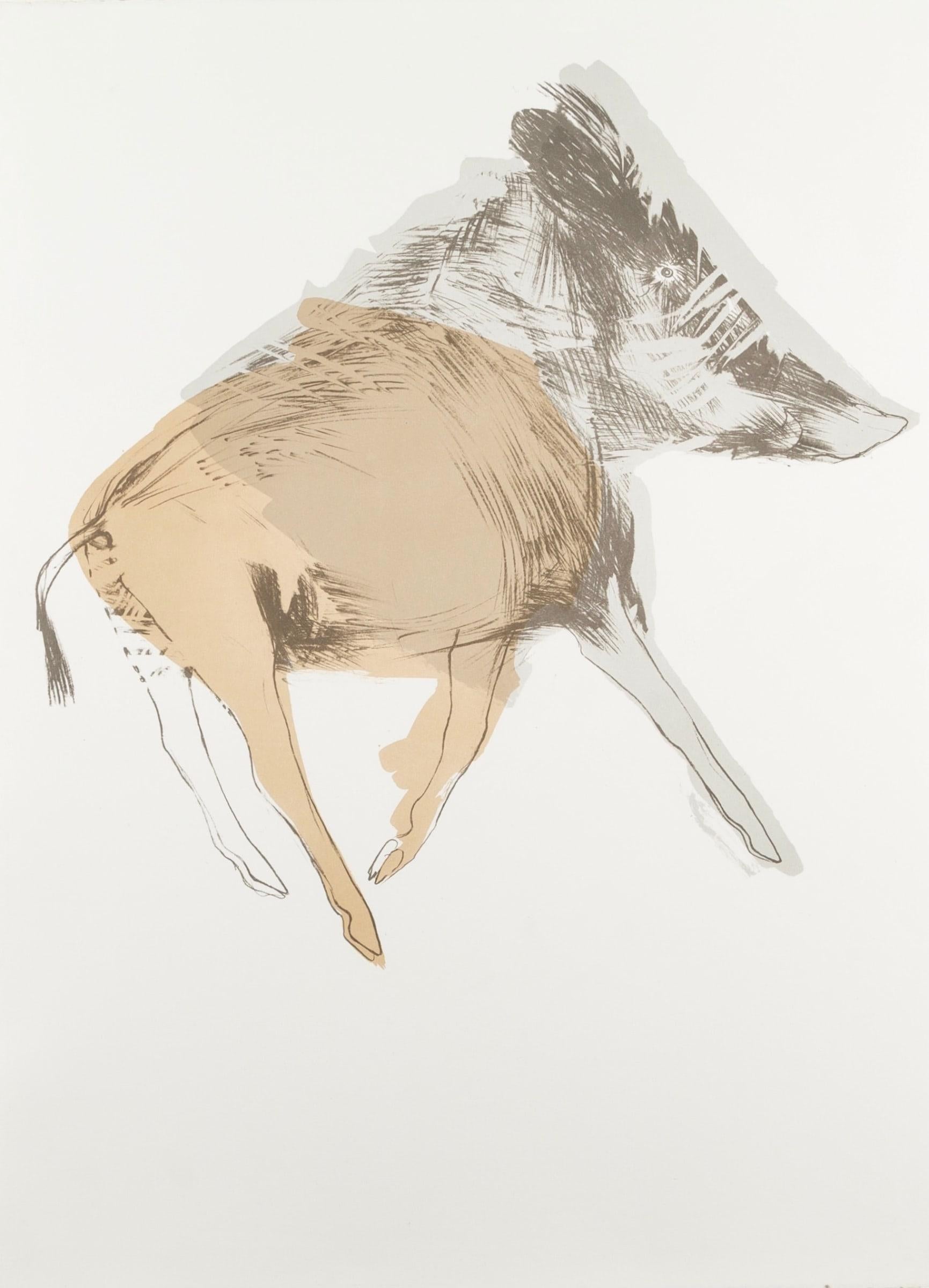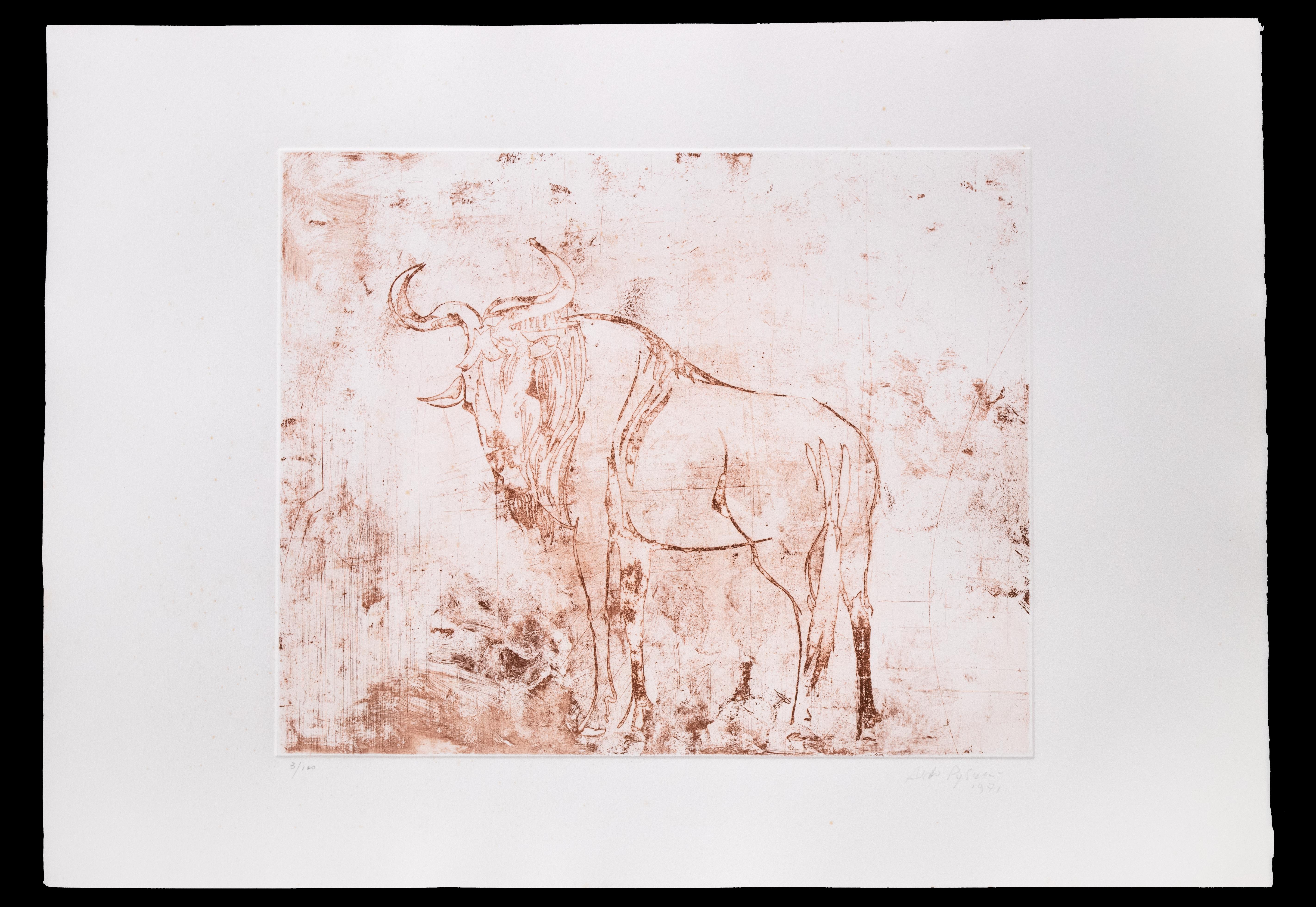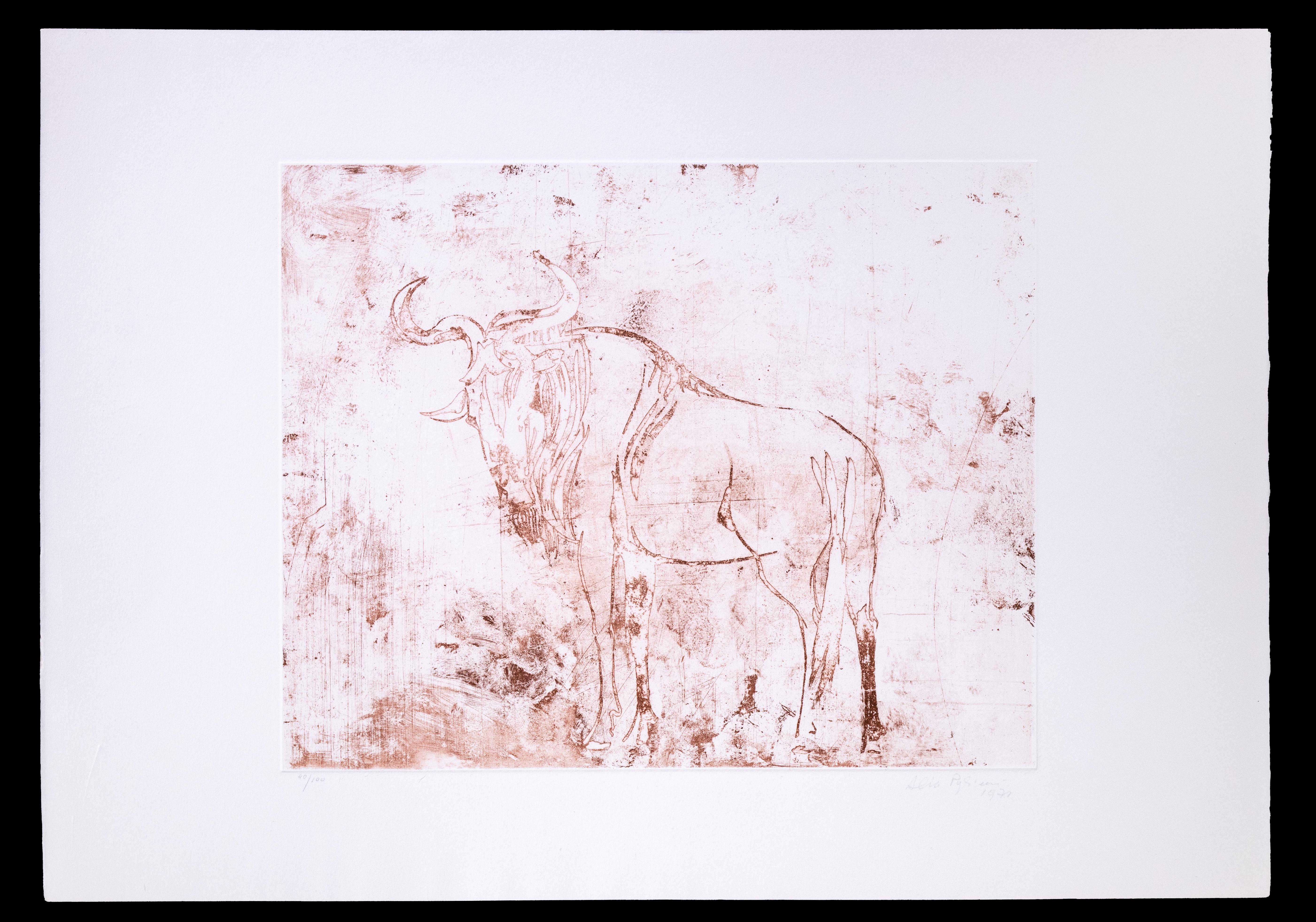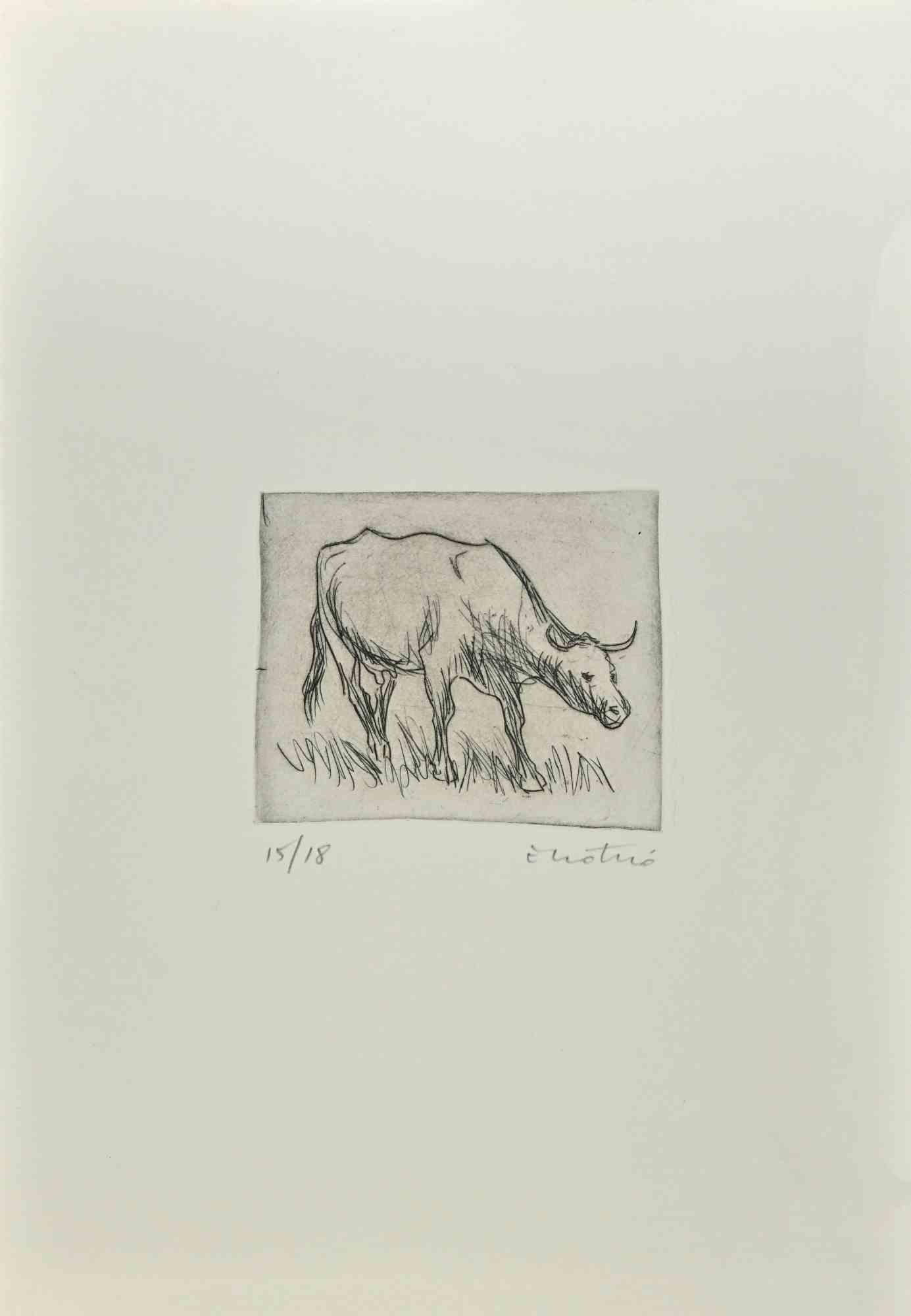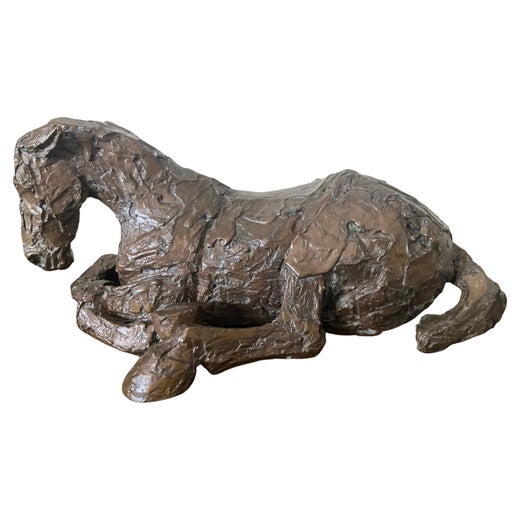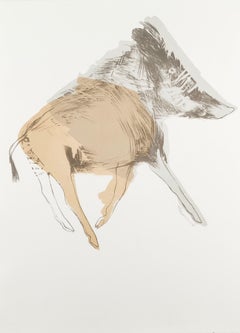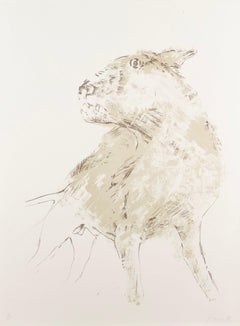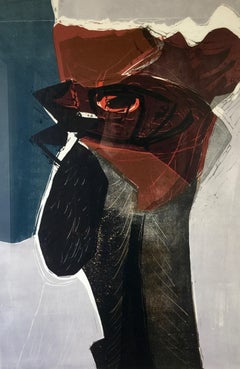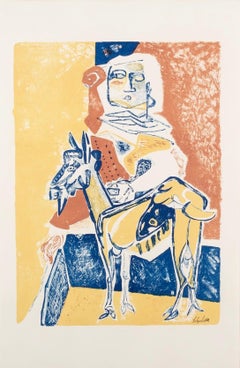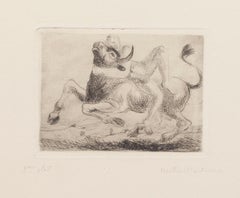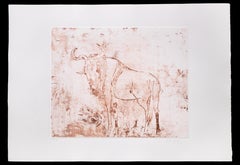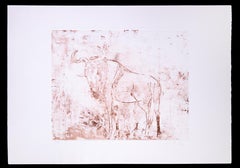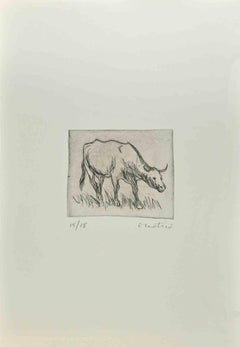Items Similar to Bull, from Images by Elisabeth Frink, 1967
Want more images or videos?
Request additional images or videos from the seller
1 of 6
Elisabeth FrinkBull, from Images by Elisabeth Frink, 19671967
1967
$5,063.78
£3,750
€4,369.34
CA$7,107.53
A$7,752.19
CHF 4,076.03
MX$93,029.73
NOK 51,464.34
SEK 48,002.19
DKK 32,632.57
About the Item
Bull, from Images by Elisabeth Frink, 1967
Additional information:
Medium: lithograph
79 x 59 cm
31 1/8 x 23 1/4 in
signed and inscribed 'D' in pencil
Dame Elisabeth Jean Frank was an English sculptor and printmaker.
Born in Thurlow, Suffolk, Frink studied at the Guildford School of Art (1946–1949), under Willi Soukop, and at the Chelsea School of Art (1949–1953). She became part of a post-war group of British sculptors dubbed the Geometry of Fear School that included Reg Butler, Bernard Meadows, Kenneth Armitage and Eduardo Paolozzi. Frink’s subject matter included men, birds, dogs, horses and religious motifs, but very seldom any female forms. Her sculpture, lithographs and etchings drew on archetypes of masculine strength, struggle and aggression, a truly post-war artist.
Frink spent the early part of the war in Suffolk, witnessing damaged craft returning on fire and their tangled remains crashing into the otherwise peaceful English countryside. Representing Great Britain at the 1952 Venice Biennale, Frink was described by Herbert Read as “the most vital, the most brilliant and the most promising of the whole Biennale”. In the rugged, brutal and often contorted surfaces of her work, commentators see evidence of a post-war mood that reflected the destruction, terror and brutalisation of almost six years of worldwide conflict.
Frink's first real artistic success was 'Bird' (1952; Tate, London), to be one of many avian sculptures, typical of her early work with its characteristic alert and menacing stance. Although she made many drawings and prints, she is most widely known for her monumental bronze sculptures, which have a distinctive cut and worked surface. This was created by casting from an original armature that was built up with plaster, then worked back with a chisel and surform. The process contradicts the very essence of "modelling form" established in the tradition and defined by Rodin's handling of clay.
In the 1960s and '70s, Frink’s fascination with the human form was evident in a series of falling figures and winged men. While living in France from 1967 to 1970, she began a series of threatening, monumental male heads, known as the "goggled heads." On returning to England, she focused on male nudes, barrel-chested, with mask-like features, attenuated limbs and a pitted surface, for example, 'Running Man' (1976; Pittsburgh, PA, Carnegie Mus. A.).
The 1980s held capstones for Frink's career. In 1982, a publisher proposed to produce a catalogue raisonné of her work, while the Royal Academy planned a mid-career retrospective. The date of the exhibition, originally 1986, was moved forward by a year due to demands at the gallery; this would not have been a problem lest for Frink's notoriously busy work schedule.
Then, in 1985 alone, she was committed to two major projects: a set of three figures for a corporate headquarters, one of which was a nearly seven-foot-tall male nude; and the other, a grouping entitled 'Dorset Martyrs' to be placed in Dorchester. However, despite the potential for conflict, the retrospective was a success and spurred the art world to hold more exhibitions of Frink's worth, with four solo exhibitions and several group ones coming in the following year.
Tirelessly, Frink continued to accept commissions and sculpt, as well as serve on advisory committees, meet with art students who had expressed an interest in her work and pursue other public commitments. Frink kept up this hectic pace of sculpting and exhibiting until early 1991 when an operation for cancer of the oesophagus caused an enforced break. However, a few short weeks later Frink was again sculpting and preparing for her exhibitions. In September, she underwent a second surgery. Again, Frink did not let this hold her back, proceeding with a planned trip for exhibitions to New Orleans, Louisiana, and New York City.
The exhibitions were a success, but Frink's health was clearly deteriorating. Despite this, she was working on a colossal statue, 'Risen Christ', for Liverpool Cathedral. This sculpture would prove to be her last; just one week after its installation, Frink died from cancer on 18 April 1993, aged 62. Her husband had predeceased her by only a few months.
Stephen Gardiner, Frink's official biographer, argued that this final sculpture was appropriate: "This awesome work, beautiful, clear and commanding, a vivid mirror-image of the artist's mind and spirit, created against fearful odds, was a perfect memorial for a remarkable great individual."
'Warhorse' and 'Walking Madonna' may be seen in the garden at Chatsworth House, with other work at the Jerwood Sculpture Park, Ragley Hall. Uniquely in England, 'Desert Quartet' (1990), Frink's penultimate sculpture, was given Grade II* listing in 2007, less than 30 years from its creation by the Department for Culture, Media and Sport. It may be seen opposite Liverpool Gardens in Worthing.
Before Elisabeth Frink died in 1993, she had given classes at the Sir Henry Doulton School of Sculpture then headed by sculptor Colin Melbourne ARA in Stoke on Trent, England. Rosemary Barnett took over as principal of the Sir Henry Doulton School of Sculpture, Stoke-on-Trent, briefly before its closure. In 1990 she met Harry Everington there and their shared artistic outlook brought about the Frink School of Figurative Sculpture. Permission from the Frink Estate was given because it was to continue the tradition which she represented. The School opened in 1996 and it attempted to give some balance to the declining figurative training and increased conceptualism in sculpture schools in the UK. David Bowie owned a number of her works.
“Sculpture is a separate thing; it does not require a wall like a picture. It does not even need a roof. It is an object that exists for itself – alone, and it is well to give it entirely the character of a complete thing about which one could walk, and which one could look at from all sides. Yet it had to distinguish itself somehow from other objects, the ordinary things that anyone could touch, handle or use. It has to become unimpeachable, sacrosanct, separated from chance and time through which it rises, isolated and miraculous, like the face of a seer. It has to be given its own certain place, where no arbitrary decision placed it, and it must be intercalated in the silent continuance of space and it’s great laws. It had to be placed into the space that surrounded it, as into a niche; it’s certainty, steadiness and gravity does not spring from its significance alone but from it’s harmonious adjustment to its environment”, (Rilke in his monograph on Rodin 1903).
- Creator:Elisabeth Frink (1930-1993, British)
- Creation Year:1967
- Dimensions:Height: 31.125 in (79.06 cm)Width: 23.25 in (59.06 cm)
- Medium:
- Period:
- Condition:
- Gallery Location:Kingsclere, GB
- Reference Number:1stDibs: LU2718214577692
Elisabeth Frink
Dame Elisabeth Jean Frink was an influential English sculptor and printmaker whose work captured the complexities of the post-war era. Born in Thurlow, Suffolk, she studied at Guildford School of Art (1946–1949) under Willi Soukop, and at Chelsea School of Art (1949–1953). Frink emerged as a key figure among the Geometry of Fear sculptors, a group of post-war British artists including Reg Butler, Bernard Meadows, Kenneth Armitage, and Eduardo Paolozzi. Her oeuvre encompassed themes of masculinity, strength, and struggle, frequently depicting men, birds, dogs, and horses but rarely female forms. Her powerful sculptures and prints evoke the raw emotional aftermath of war. Frink's early years in wartime Suffolk left a profound impression on her art. She gained international recognition at the 1952 Venice Biennale, where Herbert Read hailed her as "the most vital, the most brilliant and the most promising" artist of the event. Her early success, such as Bird (1952, Tate, London), showcased her distinctive approach, blending menace and grace in avian forms. Her innovative bronze sculptures, characterised by rugged, worked surfaces, broke with traditional modelling techniques. The 1960s and 1970s marked a period of experimentation. While living in France, she produced the monumental Goggled Heads, haunting male figures exuding threat and alienation. Returning to England, her focus shifted to male nudes with powerful, barrel-chested forms and textured surfaces, exemplified by Running Man (1976, Carnegie Museum of Art). In the 1980s, Frink's career reached new heights. A retrospective at the Royal Academy in 1985 cemented her legacy, despite a demanding schedule that included major commissions like Dorset Martyrs in Dorchester. She continued to work tirelessly, contributing to public art projects, mentoring students, and serving on advisory committees. Even after being diagnosed with cancer in 1991, Frink persisted in her creative endeavors, producing her final monumental work, Risen Christ for Liverpool Cathedral, installed just days before her death on April 18, 1993. Frink's impact on sculpture extends beyond her life. Notable works like Warhorse and Walking Madonna are displayed at Chatsworth House, while Desert Quartet (1990) earned Grade II* listing in 2007, a rare honor for a contemporary piece. Her commitment to figurative art inspired the creation of the Frink School of Figurative Sculpture in 1996, a tribute to her artistic vision. David Bowie counted her among his favorite artists, owning several of her works. As Frink herself believed, sculpture transcends function, existing as an independent and sacrosanct object, harmonising with its environment while commanding a profound presence—a philosophy vividly embodied in her enduring legacy.
About the Seller
No Reviews Yet
Vetted Professional Seller
Every seller passes strict standards for authenticity and reliability
Established in 2010
1stDibs seller since 2024
43 sales on 1stDibs
Typical response time: 9 hours
- ShippingRetrieving quote...Shipping from: Kingsclere, United Kingdom
- Return Policy
More From This Seller
View AllWild Boar, from Images by Elisabeth Frink, 1967
By Elisabeth Frink
Located in Kingsclere, GB
Wild Boar, from Images by Elisabeth Frink, 1967
Additional information:
Medium: lithograph
79 x 59 cm
31 1/8 x 23 1/4 in
signed and inscribed 'D' in pencil
Dame Elisabeth Jean Frank was an English sculptor and printmaker.
Born in Thurlow, Suffolk, Frink studied at the Guildford School of Art (1946–1949), under Willi Soukop...
Category
20th Century Animal Prints
Materials
Lithograph
Dog, from Images by Elisabeth Frink, 1967
By Elisabeth Frink
Located in Kingsclere, GB
Dog, from Images by Elisabeth Frink, 1967
Additional information:
Medium: lithograph
79 x 59 cm
31 1/8 x 23 1/4 in
signed and inscribed 'D' in pencil
Dame Elisabeth Jean Frank was an English sculptor and printmaker.
Born in Thurlow, Suffolk, Frink studied at the Guildford School of Art (1946–1949), under Willi Soukop...
Category
21st Century and Contemporary Animal Prints
Materials
Lithograph
Cock's Head by Michael Rothenstein, 1959
Located in Kingsclere, GB
Cock's Head by Michael Rothenstein, 1959
Additional information:
Medium: linocut with applied texture
72.4 x 47.9 cm
28 1/2 x 18 7/8 in
signed and numbered in pencil
Michael Rothen...
Category
20th Century Animal Prints
Materials
Linocut
Woman on Goat by Robert Colquhoun
By Robert Colquhoun
Located in Kingsclere, GB
Woman on Goat by Robert Colquhoun
Additional information:
Medium: lithograph
39 x 28 cm
15 3/8 x 11 1/8 in
Born in Kilmarnock. Met Robert MacBryde, a year his senior, at the Glasgo...
Category
20th Century Prints and Multiples
Materials
Lithograph
Reclining Figure by Henry Moore, 1967
By Henry Moore
Located in Kingsclere, GB
Reclining Figure by Henry Moore, 1967
Additional information:
Medium: lithograph
30 x 30 cm
11 3/4 x 11 3/4 in
signed, dated and numbered in pencil; further signed and dated again i...
Category
20th Century Abstract Prints
Materials
Lithograph
Cheuelere Assigne, from Witness by Gerald Laing, 1968
By Gerald Laing
Located in Kingsclere, GB
Cheuelere Assigne, from Witness by Gerald Laing, 1968
Additional information:
Medium: screenprint in colours with Mylar collage on wove paper
23 1/8 x 29 in
58.5 x 73.5 cm
signed, d...
Category
20th Century Abstract Prints
Materials
Screen
You May Also Like
Nude and Bull - Original Etching on Paper by Bertha Martini - 1980s
Located in Roma, IT
Nude and Bull is an original etching on paper realized by Bertha Martini in 1980.
The state of preservation of the artwork is very good.
The artwork represents a nude woman riding ...
Category
1980s Figurative Prints
Materials
Etching
Buffalo - Original Etching on Paper by Aldo Pagliacci - 1971
By Aldo Pagliacci
Located in Roma, IT
Buffalo is a wonderful brown burnt sienna ink linoleum original print on paper, realized in 1971 by the Italian master Aldo Pagliacci (1913-1991).
Hand-signed, dated and numbered in...
Category
1970s Contemporary Animal Prints
Materials
Etching
Buffalo - Original Etching by Aldo Pagliacci - 1971
By Aldo Pagliacci
Located in Roma, IT
Hand signed, dated and numbered. Edition of 100 prints.
Very good conditions.
Category
1970s Contemporary Animal Prints
Materials
Etching
Bull - Etching by Enotrio Pugliese - 1963
Located in Roma, IT
Bull is an Etching realized by Enotrio Pugliese in 1963.
Limited edition of 18 copies numbered and signed by the artist.
Good condition on a white cardboard.
Enotrio Pugliese (May...
Category
1960s Contemporary Figurative Prints
Materials
Etching
Bull - Etching by Enotrio Pugliese - 1963
Located in Roma, IT
Bull is an Etching realized by Enotrio Pugliese in 1963.
Limited edition of 18 copies numbered and signed by the artist.
Good condition on a white cardboard.
Enotrio Pugliese (May...
Category
20th Century Contemporary Figurative Prints
Materials
Etching
Bull - Etching by Enotrio Pugliese - 1963
Located in Roma, IT
Bull is an Etching realized by Enotrio Pugliese in 1963.
Limited edition of 18 copies numbered and signed by the artist.
Good condition on a white cardboard.
Enotrio Pugliese (May...
Category
20th Century Contemporary Figurative Prints
Materials
Etching
More Ways To Browse
Mid Century Wall Plaster Art
Female Form Sculpture
Jean English
Mid Century Walking Man Sculpture
Bronze And Plaster Nude Male Sculpture
Chromolithograph Eggs
Icelandic Falcon
Le Picador
George Rodrigue Blue Dog Paintings
Jeu De La Cape
New Orleans Jazz Festival
Ori Reisman
Owl Woodcut
Pablo Picasso Le Picador Ii
Pablo Picasso Pigeons
Prang Lithograph
Vintage Forest Service
Audubon Engraving
